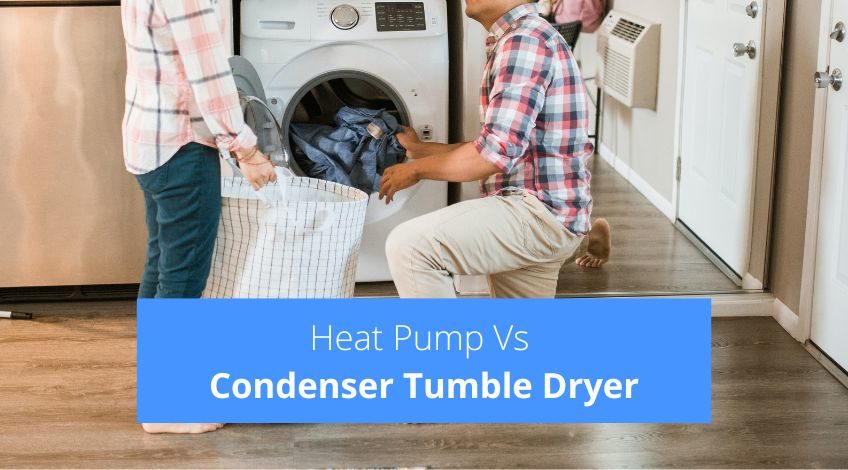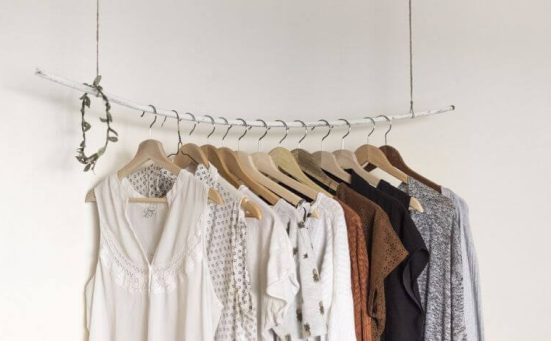 Last Updated: Jun 2024
Last Updated: Jun 2024 Heat Pump Vs Condenser Tumble Dryer (what’s the difference & which to choose)
If you’re looking to buy a tumble dryer, the choice can be confusing. Look in any store and you’ll probably see a large range of tumble dryers offered for sale. They will all look very similar from the outside, it’s the technology used to build them which makes them different.
If you’re unsure on which type of tumble dryer will suit you, check out our article on the types of tumble dryers. For more in depth comparisons between heat pump and condenser tumble dryers, keep reading.
How Much Will A Tumble Dryer Cost?
Almost everyone will be interested in the price of a tumble dryer as well as the running costs. When looking at the purchase price of tumble dryers, they range at anywhere between £180 to more than £1,500. The lowest priced are the vented models which generally range at between £180 to £280 with some being more expensive.
The mid priced range tends to be dominated with condenser tumble dryers from around £260 to £380 with some models costing more. The highest priced models tend to be heat pump tumble dryers which range from around £400 to £1,500.
Running Costs
The running costs for the 3 different types of tumble dryers show some interesting results. With the heat pump tumble dryers costing an average of £35 to £45 per year (working on an average of 3 loads per week). Whilst vented and condenser models will both cost anywhere between £70 to £90 per year to do the same 3 loads.
Obviously the running costs are dependent on the particular model of tumble dryer and the electric tariff your home is on. The prices shown are averages and not indicative of any particular home or brand of tumble dryer. But it shows that when it comes to running costs, vented and condenser tumble dryers cost around twice as much to power as the heat pump tumble dryer.
Heat pump tumble dryers have a running cost of around ½ of the running cost of condenser tumble dryers, but the initial purchase price will be higher.
You’ll need to consider how often you’re going to use your tumble dryer because there is a large difference in both the purchase price and the running cost on both types of dryer.
If you are going to only tumble dry your clothes on an odd occasion, then a cheaper purchase price and more expensive running cost will probably be a better option for you. If you intend to use your tumble dryer regularly then it would probably work out better for you to buy a model that is cheaper to run (by at least 50%) but costs more to purchase in the first place.
Tumble Dryer Types Explained

With such a large discrepancy in the cost price and running costs for the 3 different types of tumble dryer, you’re probably wondering the reason for that difference. It’s all down to the way the different types work and the technology used to build them. Keep reading for a brief explanation of each model.
Vented Tumble Dryers
At the cheaper end of the tumble dryer range are the vented models. These tend to start in price at around £180 or thereabouts. They work by drawing in air which is then passed over a heating element. It then goes through the drum, passes through your laundry and is expelled through a large pipe.
This limits where a vented tumble dryer can be installed as they need to be close to a window, door or outside wall. The hose has to vent outside of your home to prevent a build up of steam which almost always leads to mould and other problems. You can get a condenser kit to turn a vented tumble dryer into something like a condenser dryer but check with your manufacturer as these can invalidate your warranty in some cases.
Some of the more expensive vented models have smart sensors, reverse action and other settings designed to be gentler on your clothes. Whilst lower priced models tend to be more basic. However, of the 3 types, vented models tend to dry clothes the quickest. But they’re the least energy efficient of all types of tumble dryers which means they will cost more to run.
Condenser Tumble Dryers
These tend to be the most popular type of tumble dryer and purchase prices are around midway on the pricing scale. They draw air in and heat it in a similar way to vented models but it’s what happens next which differentiates them from vented dryers. The hot, moist air is expelled into a container where it hits a cool surface which condenses that air into water which is then trapped in a reservoir.
This reservoir or tank will need to be emptied frequently (it’s best to get into the habit of emptying the tank after each use). There are some condenser tumble dryers that need to be connected to the home’s drainage system via an outlet hose which will probably need expert installation.
Condenser dryers tend to be slower and less energy efficient than vented models, and if you use the “quick dry” function they’re even less energy efficient. Unlike vented models, condenser tumble dryers don’t need any external ventilation and can therefore be sited almost anywhere (within reason) and don’t need to be near an outside wall or window.
Heat Pump Tumble Dryers
When it comes to running costs, heat pump tumble dryers are the cheapest. However they are also the dearest to buy. If you tumble dry your laundry regularly, a heat pump model will probably be your best option.
They work in a similar way to condenser tumblers in as much as they have a water reservoir that needs emptying regularly. But unlike condenser models, the heat pump tumble dryer reuses the heat generated. They also don’t use a heating element to heat the air, they have a system more like an air conditioning unit or a refrigerator.
The basic principle is the same, hot air is passed through the drum but on leaving the drum, that air is then compressed and passed through an evaporator. The water is extracted and dropped into the reservoir, but instead of venting the warm air, it is reused via the pump.
As the hot air is reused, heat pump tumble dryers are far more energy efficient than the other 2 types of dryers. But they take longer to dry clothes, however the technology is ever evolving and as new models are introduced they will become faster.
The more expensive models have more features like smart phone connectivity, extra programs and are also quieter when running.
Condenser Dryers & Heat Pump Dryers What’s The Difference?
If you’re still confused over the differences between condenser and heat pump tumble dryers here’s a quick summary.
- Heat pump and condenser tumble dryers do basically the same job
- Heat pump tumble dryers can be considered to be a type of condenser tumble dryer
- The difference is in the way the hot, moist air is dealt with after being extracted from the laundry in the drum
- Condensers turn all of that warm air into water
- Heat pumps reuse most of the heat generated by that steam
- Heat pump dryers cost more to purchase, but far less to run
- Condenser dryers are quieter in operation than heat pump models
- Heat pump dryers take longer to dry laundry compared to condenser dryers
- Heat pump dryers use around 50% of the energy needed to run condenser dryers
- Heat pump tumble dryers are kinder on your laundry
Which Tumble Dryer Should I Buy?
This ultimately comes down to your personal preference, budget and lifestyle. Vented models are the cheapest to buy, but there are some negative points to consider, they cost more to run and you are limited as to where they can be sited in your home.
Condenser dryers make more sense if you are limited on space and still want a reasonably priced machine. However if you intend to use the tumble dryer regularly, a heat pump tumble dryer will be your best option.
If you have a large family, and need to get clothes dry fast, a condenser dryer will probably be your best bet. However if saving energy and reducing your carbon footprint is important to you, and you don’t mind a larger purchase price – then a heat pump tumble dryer will be your best choice.
Frequently Asked Questions
The disadvantages of a heat pump tumble dryer are, a greater purchase price, and the laundry will take longer to dry.
Heat pump tumble dryers are similar to condenser tumble dryers in as much as neither type needs an external vent and all of the moisture is collected in an internal reservoir that requires emptying. However the way they operate is different, heat pump tumblers are far more energy efficient. Heat pump tumble dryers take longer to dry clothes but at a cheaper running cost. Plus your laundry is less likely to get damaged in a heat pump model as the programs are less harsh.
Heat pump tumble dryers do take longer to dry clothes in comparison to condenser tumble dryers. But usually only by around 15 to 20 minutes and a heat pump model will use around ½ as much energy as a condenser model.
Heat pump tumble dryers are far better for the environment and way cheaper to run. They use around 50% less energy and are gentler on your laundry. So if saving money on energy and cutting down your carbon footprint are important, then yes, a heat pump tumble dryer is worth the extra money.
Heat pump dryers do not make the room hot, they reuse the heat to dry your laundry which in turn uses far less energy, keeping your energy bills lower.









![AEG 7000 SensiDry Freestanding Tumble Dryer TR718L4B, 8 kg, Heat Pump Technology, Gentle Drying, PreciseWash Adjust Time & Energy Usage Based On Load Size, White [Energy Class A++]](https://m.media-amazon.com/images/I/41pScU0EV6L._SL160_.jpg)





